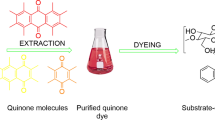Abstract
The photolysis of hop-derived trans-iso-a-acids (2a–c; naturally occurring bitter compounds present in beer) and of trans-tetrahydroiso-a-acids (5a–c; semi-synthetic advanced hop products) was investigated at 300 nm in methanol. The complex photoreaction mixtures were separated by high-performance liquid chromatography (HPLC) using diode array detection and the major photoreaction products were identified by HPLC–mass spectroscopy. The main part of the mixture consisted of compounds, which originated from recombination of radicals derived from Norrish Type I photocleavage of the acyloin moiety in both trans-iso-a-acids and trans-tetrahydroiso-a-acids. The results confirm the intermediacy of radicals that were previously identified by time-resolved electron paramagnetic resonance and they bear relevance to the formation of the lightstruck flavour that is generated when beer is exposed to light. Additionally, new photoproducts were found that are formed by photochemical reactions hitherto undiscovered in hop chemistry, including photoenolization of trans-isohumulone (2a) leading to trans-alloisohumulone (13a) and a retro oxa-di-p-methane rearrangement in trans-isohumulone (2a) and trans-tetrahydroiso-a-acids to humulone (1a) and tetrahydro-a-acids (23a–b), respectively.
Similar content being viewed by others
References
C. Lintner, in Lehrbuch der Bierbrauerei, Verlag Vieweg und Sohn, Braunschweig, 1875, p. 343.
P. Gray, I. Stone and H. Rothschild, The action of sunlight on beer, Wallerstein Lab. Commun., 1941, 4, 29–40.
Y. Kuroiwa and H. Hashimoto, Composition of sunstruck flavour substance and mechanism of its evolution, Proc. Am. Soc. Brew. Chem., 1961, 28–36.
Y. Kuroiwa, N. Hashimoto, H. Hashimoto, E. Kobuko and K. Nakagawa, Factors essential for the evolution of sunstruck flavor, Proc. Am. Soc. Brew. Chem., 1963, 181–193.
U. Kattein, H. Miedaner and L. Narziß, Zur Problematik des Lichtgeschmacks im Bier, Monatsschr. Brauwiss., 1988, 41, 205–208.
S. Sakuma, Y. Rikimaru, K. Kobayashi and M. Kowaka, Sunstruck flavor formation in beer, J. Am. Soc. Brew. Chem., 1991, 49, 162–165.
A. J. Irwin, L. Bordeleau and R. L. Barker, Model studies and flavor threshold determination of 3-methyl-2-butene-1-thiol in beer, J. Am. Soc. Brew. Chem., 1993, 51, 1–3.
H. Goldstein, S. Rader and A. A. Murakami, Determination of 3-methyl-2-butene-1-thiol in beer, J. Am. Soc. Brew. Chem., 1993, 51, 70–74.
P. Hughes, The lightstruck flavour problem, Cerevisia, 1999, 24(2), 21–25.
M. Verzele and D. De Keukeleire, Chemistry and Analysis of Hop and Beer Bitter Acids, Elsevier, Amsterdam, 1991. It should be noted that the stereochemical descriptors cis and trans refer to the relative positions of the tertiary hydroxy group at C(4) and the side chain at C(5).
G. M. A. Blondeel, D. De Keukeleire and M. Verzele, The photolysis of isohumulone to dehydrohumulinic acid, a key route to the development of sunstruck flavour in beer, J. Chem. Soc., Perkin Trans. 1, 1987, 1, 2715–2717.
C. S. Burns, A. Heyerick, D. De Keukeleire and M. D. E. Forbes, Mechanism for formation of the lightstruck flavor in beer revealed by time-resolved electron paramagnetic resonance, Chem. Eur. J., 2001, 7, 4553–4561.
H. A. Thornton, J. Kulandai, M. Bond, M. P. Jontef, D. B. Hawthorne and T. E. Kavanagh, Preparation of trans-iso-alpha-acids and use of their dicyclohexylamine salts as a standard for iso-alpha-acids analysis, J. Inst. Brew., 1993, 99, 473–477.
P. S. Hughes, Preparative regime for the purification of bitter acids derived from hops (Humulus lupulus L.), J. Chromatogr. A, 1996, 731, 327–330.
B. A. Hay, J. W. Homiski and J. L. Howie, Differences in ultraviolet absorbance of tetrahydroiso-a-acid components, J. Am. Soc. Brew. Chem., 1994, 52, 54–56.
P. J. Wagner and G. S. Hammond, Properties and reactions of organic molecules in their triplet states, Adv. Photochem., 1968, 5, 21–156.
D. De Keukeleire and G. M. Blondeel, The mechanism of the regio- and stereospecific photorearrangement of humulone to the beer bitter component trans-isohumulone, Tetrahedron Lett., 1979, 15, 1343–1346.
It was unequivocally proven (see ref. 7) that dihydroiso-α-acids–in which the carbonyl group in the 4-methylpent-3-enoyl side chain at C(4) of the iso-a-acids is hydrogenated to a secondary alcohol–do not give rise to formation of radicals and, consequently, they do not undergo photochemical decomposition, as was also observed in our preliminary photostationary irradiation experiments.
Author information
Authors and Affiliations
Corresponding author
Additional information
Dedicated to Professor Jean Kossanyi on the occasion of his 70th birthday.
Rights and permissions
About this article
Cite this article
Heyerick, A., Zhao, Y., Sandra, P. et al. Photolysis of hop-derived trans-iso-α-acids and trans-tetrahydroiso-α-acids: product identification in relation to the lightstruck flavour of beer. Photochem Photobiol Sci 2, 306–314 (2003). https://doi.org/10.1039/b210935b
Received:
Accepted:
Published:
Issue Date:
DOI: https://doi.org/10.1039/b210935b




